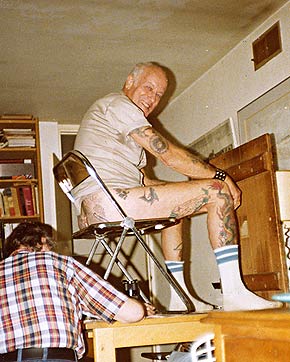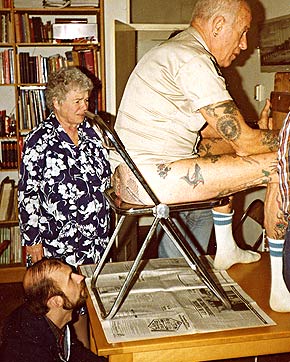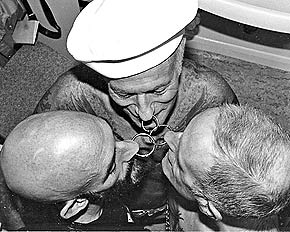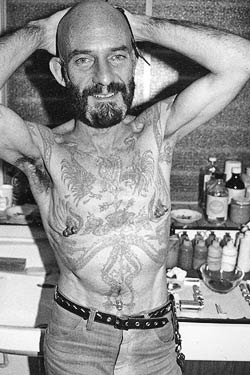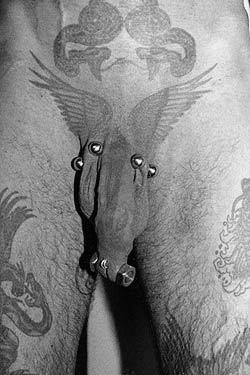
In March of 1978 the ITAA put on another tattoo convention, this time in Amsterdam. Doug and I decided we would attend. While vending was not an option, it was, nonetheless, and opportunity to meet people and proselytize for our favorite form of body art. Somehow our plans evolved into a month long vacation with Sailor Sid and Elizabeth Weinzirl
joining us through most of it.
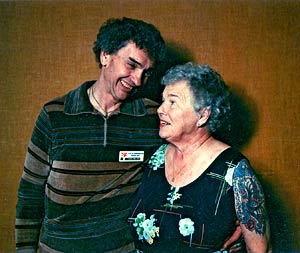 Doug Malloy and Elizabeth Weinzirl at the ITAA tattoo convention in Reno, 1977.
Elizabeth Weinzirl had a reputation as the grandmother of the tattoo community. At the time of this trip she was in her mid 70s though she could easily have passed for 60. She was a widow, her husband having been dead for a number of years.
Elizabeth’s husband had been a health inspector. I probably wouldn’t even remember the fact except she told the story of his going to inspect a Chinese restaurant. When he pointed out a mass of garbage that needed to be disposed of, the chef replied indignantly, “Not garbage. Soup stock.” When asked why she got tattooed, she said that her husband wanted a tattooed wife. She considered the options and decided to get tattooed. Some feminists might find this offensive, but it was said tongue in cheek and with a twinkle in her eye. There was never any hint that she felt coerced, and my feeling was that she shared her husband’s interest in and enthusiasm for body art. She even confessed that she had had her nipples pierced at one time, but for some reason had taken the jewelry out. We arrived at Heathrow on Tuesday, March 7th for a week in London prior to moving on to the Continent. Our main reason for this lengthy stay was in order to spend some quality time with Alan Oversby, better know in piercing and tattoo circles as Mr. Sebastian. We also wanted to meet as many other British piercing enthusiasts as possible. Accommodating the four of us wasn’t possible in Alan’s small apartment — or flat as he would have called it — so he had made arrangements for us to stay with different friends.
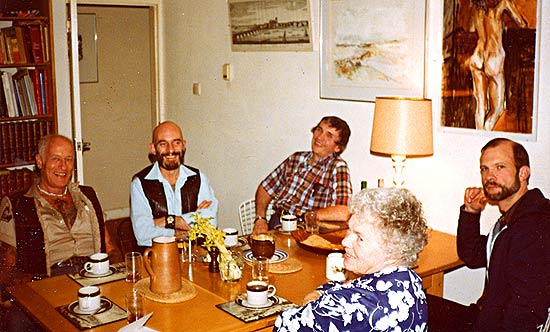 Around Alan’s dinner table, left to right, Sid, Alan, Doug, Elizabeth, and myself.
Not surprisingly Sid was his usual boisterous self, never missing an opportunity to joke around. While we were visiting with Alan, Sid happened to notice some folding chairs with clear plastic seats. It wasn’t long before he had instigated a photo op: getting a picture of his guiche and ass tattoo through the seat of the chair.
Sadly, also missing are most of the photos that were taken at a cocktail party that was given in our honor. A dozen or more of Alan’s clients showed up. Elizabeth was the only woman present and was perfectly at ease as the clothes came off and the cameras began clicking. The few surviving photos I have are mostly closeups taken by myself or Sid or Alan.
During our stay in London I took advantage of the opportunity to interview Alan for PFIQ. Prior to becoming a tattooist Alan had worked as an art teacher. There’s no doubt his background as an artist was of great benefit when he left teaching to pursue his passions for tattooing and piercing.

 Ceramic egg made by Alan and presented by him to Doug.
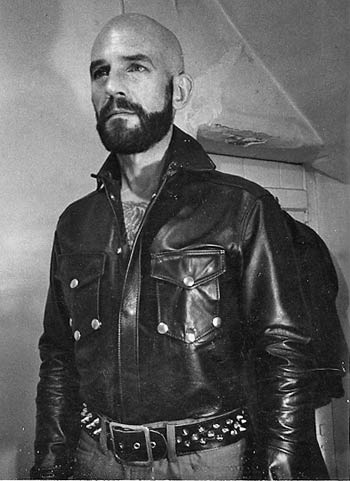 A younger Alan.
Mr. Sebastian’s space was meticulously clean and well organized. I would have expected no less. While we differed in our viewpoints on a number of issues, he and I shared a commitment to cleanliness and proper hygiene.
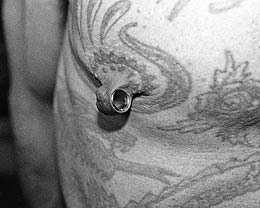 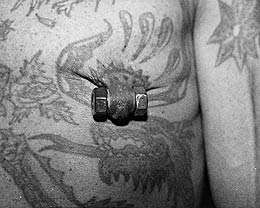 Alan’s stretched nipple piercings.
I strongly rejected the use of injectable anesthetics. From my perspective they were too risky to be used by anyone who wasn’t a physician or at least a nurse. This sense of danger arose from a couple of concerns. For one they can pose a health risk to some people. That’s bad enough, but a far more immediate concern was that in the US their use is illegal in the hands of an unlicensed individual. Assuming I could even have obtained them, I would have been putting my fledgling business at risk of being closed down and myself at risk of arrest for practicing medicine without a license. From my perspective it simply wasn’t worth taking a chance. I also felt, and still do, that when piercings are done by a skilled piercer, the pain isn’t significantly greater than the anesthetic injection would be. As the years went by and I observed other piercers at work, I came to the conclusion that oftentimes they used anesthetics to mask their incompetence and lack of skill. It became my firm belief that the best thing a piercer could do to minimize discomfort and pain was to master the necessary skills and be able to perform a piercing quickly and accurately. This, in my opinion, eliminates the need for anesthetics of any kind. Even though the legality of their use in Britain was not much different than in the US, Alan never seemed to be particularly concerned. He was able to obtain anesthetics through a physician friend and had no qualms about using them. I must be honest; I had very little opportunity to watch Alan at work. Some years later I saw a video in which he performed a Prince Albert piercing, and I was a bit surprised by his technique. The piercing was done within the context of an S/M scene, and I’ve wondered if the crudeness was for effect and to deliberately prolong the discomfort. It took an inordinate amount of fumbling and time, and seemed to be more bloody than usual for this often bloody piercing. It left me wondering if Alan’s technique could have used some refinement and if it might explain his regular use of anesthetics.
 Alan and a friend.
 Eddie, a client of Alan’s and a co-defendant in the Spanner Case.
More information on the Spanner case: Mr. Sebastian is considered by many — and justly so — as the father of the modern body piercing movement in Europe. Sad to say living on opposite sides of the world wasn’t conducive to our spending much time together. The Internet was still in its infancy, and with the pressures of our businesses and lives, we weren’t very good correspondents, so communication between us was minimal. Still, I am happy to have known him personally and to have shared the spotlight with him.
Jim Ward IAM members click here to discuss this article.
 Jim Ward is is one of the cofounders of body piercing as a public phenomena in his role both as owner of the original piercing studio Gauntlet and the original body modification magazine PFIQ, both long before BME staff had even entered highschool. He currently works as a designer in Calfornia where he lives with his partner.
Copyright © 2005 BMEZINE.COM. Requests to publish full, edited, or shortened versions must be confirmed in writing. For bibliographical purposes this article was first published July 15th, 2005 by BMEZINE.COM in Amsterdam, The Netherlands. |

